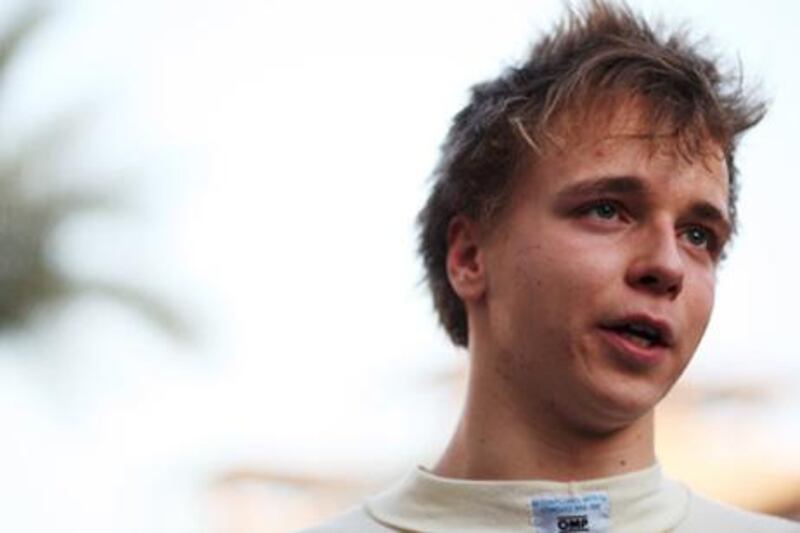Kevin Korjus stands in the paddock at Yas Marina Circuit, his race suit looking decidedly too large, his shaggy mop of brown hair matted to his brow and a bead of sweat running down the side of his childlike face.
This moment, captured by two photographers, could prove monumental; a remarkable Emirates-based transition of a karting conqueror into a Formula One fledgling.
It is four years since Korjus, an 18-year-old Estonian, first visited the UAE to compete in the highly regarded Rotax Max Challenge Grand Finals. Staying for only eight days, he recalls the long drive from Dubai to Al Ain, past a construction site that would later become the world's tallest building and through a barren desert dotted with camels.
"When I first arrived in the Emirates in 2007, I was surprised by the country," Korjus said. "It was around 35 degrees, but I live in North Europe and in Estonia we have-5 or -10 degrees. Also, here, everywhere is sand, whereas everywhere back home is snow, so for me it was obviously really different."
Fortunately, asphalt is the same in all countries and when he reached the Al Ain Raceway, he proceeded to triumph in the Junior Max 125 category. As a 14-year-old, he had won previous karting championships in Estonia and was crowned Baltics champion earlier in 2007, but his victory in the Garden City was his first international karting success. It was a victory that took time to sink in.
"When I won the race, it all happened so quickly," he said. "It was only a few days later, once I was at home, that it came to me and I was like: 'That's cool, I won the world championship.' Afterwards, when I found myself thinking, everything felt perfect."
The success spurred him to shift into single-seaters for 2008, where he impressed in Formula Renault 2.0 Finland, racing 12 times and finishing on the podium in all but one race.
By 2010, he had progressed to racing in the two-litre Eurocup, which he won to become the youngest driver ever to do so. The achievement led to a deal with Gravity Sports Management, the company part-run by Eric Boullier, team principal of Lotus-Renault.
Korjus was also enrolled in Renault's Driver Development Programme and this season has been racing in the Formula Renault 3.5 series. He caught the eye immediately with a number of solid performances, none more impressive than his pole-to-flag victory at the Ciudad del Motor de Aragon in Spain.
The race win, achieved while Korjus was 18 years, three months and eight days old, saw him usurp Charles Pic as the series' youngest race winner. Pic previously held the record after winning in Monaco in May 2008.
The Frenchman is widely expected to be announced this weekend as a Formula One driver with Virgin Racing for next season.
In October, with Korjus finishing sixth in the Formula Renault 3.5 championship, he was called to a number of meetings with Renault chiefs, including Boullier. It was discussed that he may be furnished his first experience behind the wheel of a Formula One car. The date discussed was during the three-day Young Drivers Test programme in Abu Dhabi.
"Inside, I was obviously really hoping I could do it, but it was still kind of a surprise when it was confirmed," he said. "Obviously, it feels like one of my dreams come true. Four years ago, I wasn't thinking about this at all and now I am back here, so I'm very happy to be given this kind of opportunity."
On Wednesday, November 16, 2011, Korjus completed 70 laps of Yas Marina Circuit as part of the annual Young Drivers Test. His lap time was 1.5 seconds slower than that of Robert Wickens, the Canadian who won last season's Formula Renault 3.5 and is also a reserve driver for Virgin Racing. Wickens had completed 101 laps at Yas courtesy of his involvement in first practice at the Abu Dhabi Grand Prix and an opening-day test with Renault.
It was an admirable showing, all considering.
"The biggest surprise for me was the number of things a driver has to do while driving the car - it's unbelievable," he said, having stepped out, visibly drained, from the cockpit of the Renault R31.
"The brakes also surprised me. And the number of people who are working for one person; there are about 20 people working around the car all doing their own thing."
Two days earlier, when Korjus had emerged from the arrivals hall at Abu Dhabi International Airport, he had instigated chortling from his would-be employers.
"The racing helmet he had brought with him was so filthy, I'm surprised he could see through it," said a Renault team member. "We polished it up for him, though, so now not only can he see through it, but it smells nice, too. We like to give our young drivers the complete Formula One experience."
Korjus, who was put up in the Crowne Plaza in the city, appreciated it. "All the team have treated me very well and like a real driver, so it makes me feel good inside," he said. "I think in racing, though, it is good if you don't fly too high in the sky: Keep your feet on the ground and do the best job wherever you are at. I just want to do the best job I can next year in the World Series for Renault championship."
In order to dedicate himself entirely to his driving, Korjus dropped out of school in September. Now, while his friends "are playing in the snow or skiing", he is preparing to continue his pursuit of his dream.
"My main goal now is try and focus on racing for a few years and see how far I can get," he said "I will have time to finish my schooling whenever I want, but I will not always have the opportunity to be a racing driver."





